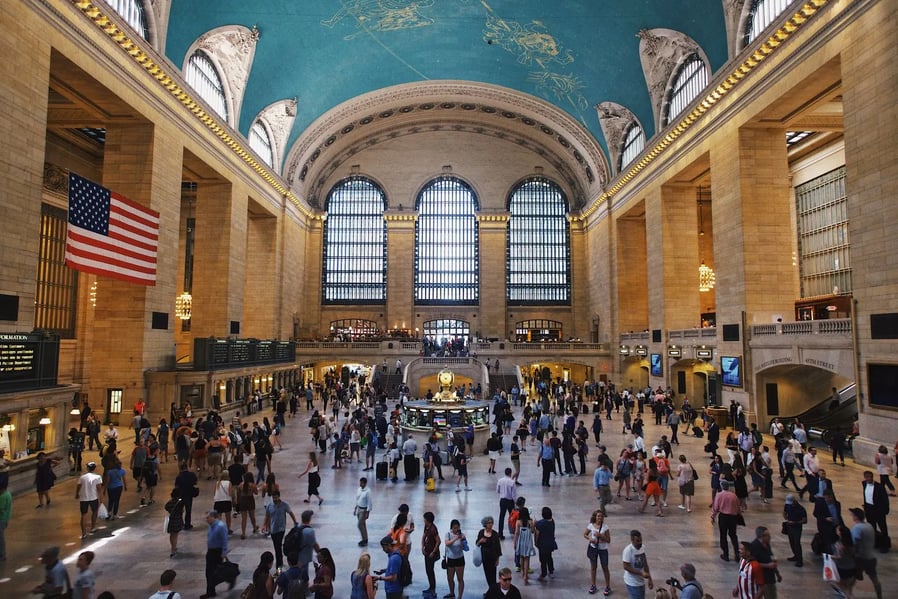
Discover These 9 Historic Landmarks During Your NYC Stay
New York City may be best-known for its attractions like its world-class museums, awe-inspiring skyscrapers, and iconic avenues, but it is also an incredible repository of history. From its founding as a Dutch trading post in 1624 to its brief role as the capital of the United States in the 1700s, New York City is home to an enduring historical legacy.
This historical legacy can be explored throughout various fascinating landmarks, from the vaunted Carnegie Hall to old Trinity Church. Continue reading to learn more about our nine most highly-recommended historic landmarks.
1. Federal Hall
Located on Wall Street, itself a historically important site, Federal Hall was New York City’s first City Hall, the site of the country’s first Congress, as well as the place where George Washington was sworn in as the country’s first president. Though the original building was demolished in 1812, the current Greek-Revival style hall serves as a museum documenting the inception of the United States and the presidential terms of George Washington.
2. Fraunces Tavern
Sip a beer in the same place where Founding Fathers once sat during a visit to Fraunces Tavern. This museum and restaurant was once headquarters for George Washington, a meeting place for the Sons of Liberty, and a venue for British-American peace negotiations. The building has been reconstructed, but it is considered by some to be Manhattan’s oldest surviving building. The restaurant serves traditional pub fare, and a wide range of drinks, with a side of Revolutionary War history.
3. Trinity Church
A historic Episcopal church, Trinity Church is located at the intersection of Wall Street and Broadway. The current building dates back to the mid 1800s, but the original Trinity Church was chartered by King William III in 1697. Trinity Church played a role in the American Revolution; George Washington attended a service there after his inauguration, and loyalist clergy clashed with their patriotic brethren. The Church is a testament to the religious history of the city, dating back to before the Revolution.
4. Grand Central Station
Originally known as Grand Central Depot, this train station was built by railroad magnate Cornelius Vanderbilt in 1871. At the time, it was the biggest construction project in New York City to date, and it was all-electric, setting it apart from almost all other buildings at the time. The building is a premier example of Beaux-Arts architecture, which was especially popular in New York’s Gilded Age. Grand Central has a grand legacy in pop culture, and an important role in the lives of many commuters and visitors to the city.
5. St. Agnes Library
Part of the New York Public Library system, the St. Agnes branch was built in 1893 as the parish library for a nearby chapel. It is located on the leafy Upper West Side of the city, off of Amsterdam Avenue. Built with funds donated by Andrew Carnegie, St. Agnes Library was once home to a collection for the Library of the Blind. It was consolidated with the New York Public Library in 1901.
6. City Hall Park
Home to historic protests, centuries-old government buildings, and civic life, City Hall Park is an important monument to democratic rule. It was the town commons for early New York City, and it now surrounds New York City Hall. In 1765, it was the site of New Yorkers’ protests over the Stamp Act, and it was the site of the Sons of Liberty’s first ‘Liberty pole’ installation. It is now a lush, refreshing green spot in the middle of downtown, but it still overflows with history.
7. Castle Clinton
Located at the tip of Manhattan, in Battery Park, Castle Clinton—also known as Fort Clinton—was America’s first immigration station, as well as an exhibition hall, aquarium, and beer garden over the years. Built in 1811, it processed over 8 million immigrants arriving in the country between 1855 and 1890; prior to that, however, it was a fortification meant to ward off a British invasion. It is a fascinating naval fortification and a testament to the stories of millions of people.
8. Carnegie Hall
Possibly one of the world’s most famous concert halls, Carnegie Hall was built between 1889 and 1891 by Andrew Carnegie for the Oratorio Society of New York and the New York Symphony Society. It seats over 3,000 and it is built in the Italian Renaissance style. Both its iconic facade and its excellent musical performances make it worth a visit; some of the world’s most renowned musicians, from Isaac Stern to Tchaikovsky to Billie Holiday have graced its stages.
9. Gracie Mansion
Officially the Archibald Gracie Mansion, this estate is the residence of New York City’s mayors. Built in 1799, Gracie Mansion overlooks the East River, and certain floors are open to the public as a museum. In 1801, it was the location of the founding of the New York Post. The mansion’s museum collection includes materials on the city’s history, prominent artists, social justice movements, and more.
Looking for world-class accommodations in the Upper West Side? Stay at The Lucerne for easy access to the nine activities listed above.


